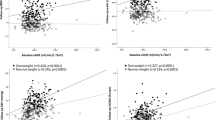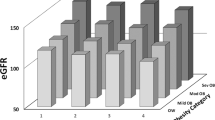Abstract
Background/Objectives:
Chronic kidney diseases are associated with changes in cardiometabolic risk (CMR) factors in which body composition parameters have been used as sensitive predictors. This study aimed to explore the associations of anthropometric indicators, body fat (BF), body mass index (BMI) and waist circumference (WC) with estimated glomerular filtration rate (eGFR) in an adult healthy Chinese population.
Subjects/Methods:
A cross-sectional study was conducted for the subjects undergoing annual health examinations. The associations of subjects with body composition parameters were analyzed using the cutoff values of BMI, BF and WC in accordance with the criteria for Asian or Taiwanese population by gender.
Results:
A total of 3473 subjects, aged 30–45 years, who received physical examinations in 2007 were analyzed. The levels of CMR factors were significantly higher in males than in females. eGFR was negatively associated with BMI but positively related to BF. The additional roles of BMI and WC were observed in the subjects who were categorized according to BF. Females with normal weight obese were associated with increased eGFR, whereas a higher eGFR was found in males with low/normal BF and BMI or normal WC.
Conclusions:
Our data provided evidence that anthropometric parameters were associated with changes of eGFR in relatively healthy adults. Higher eGFR was observed in females with normal weight obese in whom hyperfiltration may be suspected, and this finding deserves further studies.
This is a preview of subscription content, access via your institution
Access options
Subscribe to this journal
Receive 12 print issues and online access
$259.00 per year
only $21.58 per issue
Buy this article
- Purchase on Springer Link
- Instant access to full article PDF
Prices may be subject to local taxes which are calculated during checkout
Similar content being viewed by others
References
Go AS, Chertow GM, Fan D, McCulloch CE, Hsu CY . Chronic kidney disease and the risks of death, cardiovascular events, and hospitalization. N Engl J Med 2004; 351: 1296–1305.
Fox CS, Larson MG, Leip EP, Culleton B, Wilson PW, Levy D . Predictors of new-onset kidney disease in a community-based population. JAMA 2004; 291: 844–850.
Whaley-Connell AT, Sowers JR, Stevens LA, McFarlane SI, Shlipak MG, Norris KC et al. CKD in the United States: Kidney Early Evaluation Program (KEEP) and National Health and Nutrition Examination Survey (NHANES) 1999-2004. Am J Kidney Dis 2008; 51 (Suppl 2): S13–S20.
Hsu CY, McCulloch CE, Iribarren C, Darbinian J, Go AS . Body mass index and risk for end-stage renal disease. Ann Int Med 2006; 144: 21–28.
Foster MC, Hwang SJ, Larson MG, Lichtman JH, Parikh NI, Vasan RS et al. Overweight, obesity, and the development of stage 3 CKD: the Framingham Heart Study. Am J Kidney Dis 2008; 52: 39–48.
Ritz E . Metabolic syndrome and kidney disease. Blood Purif 2008; 26: 59–62.
Poirier P, Despres JP . Waist circumference, visceral obesity, and cardiovascular risk. J Cardiopulm Rehabil 2003; 23: 161–169.
Klein S . The case of visceral fat: argument for the defense. J Clin Invest 2004; 113: 1530–1532.
Kanaya AM, Harris T, Goodpaster BH, Tylavsky F, Cummings SR, Health A et al. Adipocytokines attenuate the association between visceral adiposity and diabetes in older adults. Diabetes Care 2004; 27: 1375–1380.
Katzmarzyk PT, Leon AS, Wilmore JH, Skinner JS, Rao DC, Rankinen T et al. Targeting the metabolic syndrome with exercise: evidence from the HERITAGE Family Study. Med Sci Sports Exerc 2003; 35: 1703–1709.
Pollex RL, Hegele RA . Genetic determinants of the metabolic syndrome. Nat Clin Pract Cardiovasc Med 2006; 3: 482–489.
WHO/IASO/IOTF The Asia-Pacific perspective: redefining obesity and its treatment: Health Communications Australia Pty Ltd, 2000.
Obesity: preventing and managing the global epidemic. Report of a WHO consultation. World Health Organ Tech Rep Ser 2000; 894: i–xii. 1-253.
Ashwell M, Gibson S . Waist to height ratio is a simple and effective obesity screening tool for cardiovascular risk factors: analysis of data from the British National Diet And Nutrition Survey of adults aged 19-64 years. Obes Facts 2009; 2: 97–103.
Browning LM, Hsieh SD, Ashwell M . A systematic review of waist-to-height ratio as a screening tool for the prediction of cardiovascular disease and diabetes: 0.5 could be a suitable global boundary value. Nutr Res Rev 2010; 23: 247–269.
Deurenberg-Yap M, Chew SK, Deurenberg P . Elevated body fat percentage and cardiovascular risks at low body mass index levels among Singaporean Chinese, Malays and Indians. Obes Rev 2002; 3: 209–215.
Ruderman N, Chisholm D, Pi-Sunyer X, Schneider S . The metabolically obese, normal-weight individual revisited. Diabetes 1998; 47: 699–713.
Pinto-Sietsma SJ, Navis G, Janssen WM, de Zeeuw D, Gans RO, de Jong PE et al. A central body fat distribution is related to renal function impairment, even in lean subjects. Am J Kidney Dis 2003; 41: 733–741.
Dittmann K, Hannemann A, Wallaschofski H, Rettig R, Stracke S, Volzke H et al. U-shaped association between central body fat and the urinary albumin-to-creatinine ratio and microalbuminuria. BMC Nephrol 2013; 14: 87.
Watanabe H, Obata H, Watanabe T, Sasaki S, Nagai K, Aizawa Y . Metabolic syndrome and risk of development of chronic kidney disease: the Niigata preventive medicine study. Diabetes Metab Res Rev 2010; 26: 26–32.
Miyatake N, Shikata K, Makino H, Numata T . Decreasing abdominal circumference is associated with improving estimated glomerular filtration rate (eGFR) with lifestyle modification in Japanese men: a pilot study. Acta Med Okayama. 2011; 65: 363–367.
Chen W, Chen W, Wang H, Dong X, Liu Q, Mao H et al. Prevalence and risk factors associated with chronic kidney disease in an adult population from southern China. Nephrol Dial Transplant 2009; 24: 1205–1212.
Sun F, Tao Q, Zhan S . Metabolic syndrome and the development of chronic kidney disease among 118 924 non-diabetic Taiwanese in a retrospective cohort. Nephrology 2010; 15: 84–92.
Kitiyakara C, Yamwong S, Cheepudomwit S, Domrongkitchaiporn S, Unkurapinun N, Pakpeankitvatana V et al. The metabolic syndrome and chronic kidney disease in a Southeast Asian cohort. Kidney Int 2007; 71: 693–700.
Choo V . WHO reassesses appropriate body-mass index for Asian populations. Lancet 2002; 360: 235.
American Diabetes Association. Standards of medical care in diabetes. Diabetes Care 2004; 27 (Suppl 1): S15–S35.
Ma YC, Zuo L, Chen JH, Luo Q, Yu XQ, Li Y et al. Modified glomerular filtration rate estimating equation for Chinese patients with chronic kidney disease. J Am Soc Nephrol 2006; 17: 2937–2944.
National Kidney Foundation. K/DOQI clinical practice guidelines for chronic kidney disease: evaluation, classification, and stratification. Am J Kidney Dis 2002; 39 (Suppl 1): S1–S266.
National Cholesterol Education Program Expert Panel. Third report of the National Cholesterol Education Program (NCEP) Expert Panel on Detection, Evaluation, and Treatment of High Blood Cholesterol in Adults (Adult Treatment Panel III) final report. Circulation. 2002; 106: 3143-421.
Chuang HH, Li WC, Sheu BF, Liao SC, Chen JY, Chang KC et al. Correlation between body composition and risk factors for cardiovascular disease and metabolic syndrome. Biofactors 2012; 38: 284–291.
Helal I, Fick-Brosnahan GM, Reed-Gitomer B, Schrier RW . Glomerular hyperfiltration: definitions, mechanisms and clinical implications. Nat Rev Nephrol 2012; 8: 293–300.
Levine DZ . Can rodent models of diabetic kidney disease clarify the significance of early hyperfiltration?: recognizing clinical and experimental uncertainties. Clin Sci 2008; 114: 109–118.
Kim JY, Han SH, Yang BM . Implication of high-body-fat percentage on CMR in middle-aged, healthy, normal-weight adults. Obesity 2012; 21: 1571–1577.
Romero-Corral A, Somers VK, Sierra-Johnson J, Korenfeld Y, Boarin S, Korinek J et al. Normal weight obesity: a risk factor for cardiometabolic dysregulation and cardiovascular mortality. Eur Heart J 2010; 31: 737–746.
Prospective Studies Collaboration, Prospective Studies Collaboration Whitlock G, Prospective Studies Collaboration Lewington S, Prospective Studies Collaboration Sherliker P, Prospective Studies Collaboration Clarke R, Prospective Studies Collaboration Emberson J et al. Body-mass index and cause-specific mortality in 900 000 adults: collaborative analyses of 57 prospective studies. Lancet 2009; 373: 1083–1096.
Ashwell M, Hsieh SD . Six reasons why the waist-to-height ratio is a rapid and effective global indicator for health risks of obesity and how its use could simplify the international public health message on obesity. Int J Food Sci Nutr 2005; 56: 303–307.
Rabe K, Lehrke M, Parhofer KG, Broedl UC . Adipokines and insulin resistance. Mol Med 2008; 14: 741–751.
Tritos NA, Mantzoros CS . Leptin: its role in obesity and beyond. Diabetologia 1997; 40: 1371–1379.
Yang X, Smith U . Adipose tissue distribution and risk of metabolic disease: does thiazolidinedione-induced adipose tissue redistribution provide a clue to the answer? Diabetologia 2007; 50: 1127–1139.
Rosenquist KJ, Pedley A, Massaro JM, Therkelsen KE, Murabito JM, Hoffmann U et al. Visceral and subcutaneous fat quality and CMR. JACC Cardiovasc Imaging 2013; 6: 762–771.
Author information
Authors and Affiliations
Corresponding author
Ethics declarations
Competing interests
The authors declare no conflict of interest.
Rights and permissions
About this article
Cite this article
Tsai, YW., Ho, CI., Chen, JY. et al. Impact of body composition on estimated glomerular filtration rate in relatively healthy adults in Taiwan. Eur J Clin Nutr 69, 34–39 (2015). https://doi.org/10.1038/ejcn.2014.66
Received:
Revised:
Accepted:
Published:
Issue Date:
DOI: https://doi.org/10.1038/ejcn.2014.66
This article is cited by
-
Combined body mass index with high-sensitivity C-reactive protein as independent predictors for chronic kidney disease in a relatively healthy population in Taiwan
European Journal of Clinical Nutrition (2016)



